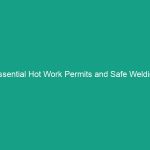Good Morning Team!
Today, we’re diving into a topic that’s crucial for our Safety and efficiency on the job: Shortcuts Are a Choice: Essential Safety Tips to Avoid Critical Risks. We all want to get our tasks done quickly, but taking shortcuts can lead to serious accidents and injuries. Let’s explore why understanding this concept is vital for our Workplace Safety and how we can effectively apply proper safety practices.
Understanding Shortcuts and Their Impact
First, let’s define what we mean by “shortcuts.” In the context of Workplace Safety, shortcuts refer to taking an easier or quicker way to accomplish a task, often bypassing established safety protocols and Procedures. While it may seem harmless in the moment, these choices can expose us to significant risks.
Shortcuts can lead to injuries, accidents, and even fatalities. The impact on our employees and the organization can be severe, leading to lost productivity, financial costs, and emotional stress. It’s crucial to understand that every time we choose to take a shortcut, we are making a choice – a choice that can have serious consequences.
Many employees believe that shortcuts are harmless or that they save time. However, this misconception can lead to dangerous situations. Let’s take a closer look at the key Hazards associated with shortcuts in our workplace.
Key Hazards, Risks, and Safety Considerations
When we talk about shortcuts, we’re often referring to specific hazards that can arise from neglecting safety protocols. Here are some common hazards to be aware of:
- Equipment Failure: Skipping safety checks can lead to machinery malfunctions, posing risks not only to the individual using the equipment but to everyone nearby.
- Inadequate Training: Bypassing training sessions or using tools and equipment without proper knowledge can result in accidents.
- Environmental Risks: Not following Safety Guidelines regarding hazardous materials can expose employees to harmful substances.
- Personal Injuries: Taking shortcuts during manual tasks can lead to slips, trips, and falls, which are among the most common workplace injuries.
Ignoring these safety protocols can lead to real-world consequences. For instance, consider a scenario where an employee skips wearing Personal Protective Equipment (PPE) while operating a machine. This choice could result in severe injuries, legal ramifications, and a negative impact on our company’s reputation.
Best Practices, Procedures, & Actionable Advice
Now that we understand the hazards, let’s discuss Best Practices to ensure safety in our workplace. Here are some actionable steps to avoid shortcuts:
- Follow Established Protocols: Always adhere to safety procedures, even if they seem time-consuming. Every step is designed to protect you and your colleagues.
- Use Proper Equipment: Ensure that you are using the right tools and equipment for the job. If you’re unsure, consult your supervisor.
- Participate in Training: Take advantage of training sessions. They are designed to equip you with the knowledge to perform your tasks safely.
- Communicate: If you notice a potential hazard or if you’re unsure about a task, speak up. Open communication can prevent accidents.
- Take Your Time: Rushing can lead to mistakes. Allow yourself the time needed to complete tasks safely.
To illustrate these points, let’s consider a brief real-world incident. In a manufacturing plant, an employee attempted to save time by not securing a load properly. This decision led to a significant accident, resulting in injuries and production downtime. This serves as a powerful reminder of the importance of following safety protocols.
Regulations, Standards, and Compliance
Compliance with safety Regulations is not just a legal obligation; it is essential for protecting our workforce. Relevant Standards set by organizations such as OSHA (Occupational Safety and Health Administration) and ISO (International Organization for Standardization) provide guidelines to minimize risks in the workplace.
By adhering to these regulations, we not only safeguard our employees but also enhance our organizational integrity and reliability. Compliance ensures that everyone understands their responsibilities and the measures in place to protect them.
Employee Engagement & Discussion
Now, let’s take a moment to reflect on our own experiences related to shortcuts. I encourage you to think about the following questions:
- Have you ever taken a shortcut that resulted in a close call or accident?
- What safety challenges have you encountered related to taking shortcuts?
- How can we as a team encourage each other to avoid shortcuts and prioritize safety?
These discussions are vital for fostering a culture of safety and accountability in our workplace. Your insights can help us improve our practices and enhance our safety standards.
Conclusion & Key Takeaways
In conclusion, remember that shortcuts are a choice, and making the right choice is critical for our safety. By understanding the hazards, adhering to Best Practices, and engaging in open discussions, we can reduce risks and create a safer workplace for everyone. Let’s commit to prioritizing safety and ensuring that we all go home unharmed at the end of the day.
Thank you for your attention and your dedication to safety. Together, we can make a difference and ensure a safer work Environment for all!


